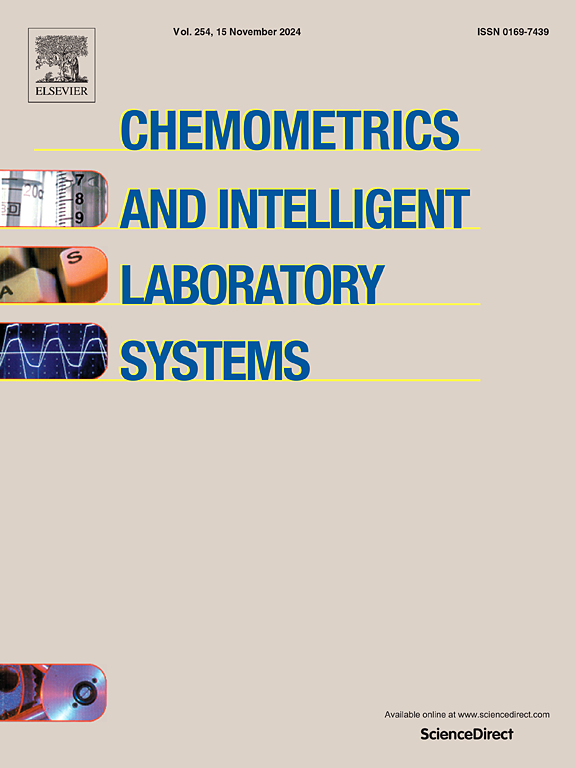An expectation–maximization algorithm for spectral reconstruction under the spectral hard model
IF 3.8
2区 化学
Q2 AUTOMATION & CONTROL SYSTEMS
Chemometrics and Intelligent Laboratory Systems
Pub Date : 2025-09-02
DOI:10.1016/j.chemolab.2025.105518
引用次数: 0
Abstract
Indirect Hard Modeling (IHM) is a physics-based evaluation method for the quantitative analysis of fluid compositions using spectroscopic techniques such as Raman spectroscopy. In this approach, mixture spectra are represented as a superposition of pure substance models, with each component described by a sum of parameterized peak functions. Nevertheless, the accuracy of the compositions prediction depends critically on user decisions regarding both the number of peak functions and the specific parameter adjustments employed. In this work, we apply an expectation–maximization (EM) based algorithm for generating spectral reconstructions of pure substance models that does not require the pre-specification of the number of peaks or any initial values. The efficient and fast performance of the used EM algorithm enables the fit of a given spectrum for an unknown number of peaks, based on a model selection criterion. In simulation studies, we demonstrate that this approach can recognize the true underlying function in settings of high noise, peak overlapping and background signals, yielding reliable results. In a validation study, the algorithm was tested using experimental data. It was integrated into an Indirect Hard Modeling framework and applied to three chemical test systems. The quality of the obtained results were in the range of other automated IHM model generating approaches while significantly reducing both time and computational effort.
光谱硬模型下的光谱重建期望最大化算法
间接硬建模(IHM)是一种基于物理的评价方法,用于利用光谱技术(如拉曼光谱)对流体成分进行定量分析。在这种方法中,混合光谱被表示为纯物质模型的叠加,每个成分由参数化峰函数的和来描述。然而,成分预测的准确性主要取决于用户对峰值函数的数量和所采用的具体参数调整的决定。在这项工作中,我们应用基于期望最大化(EM)的算法来生成纯物质模型的光谱重建,该模型不需要预先指定峰的数量或任何初始值。基于模型选择准则,所使用的电磁算法具有高效和快速的性能,可以对未知数量的峰进行给定光谱的拟合。在仿真研究中,我们证明了这种方法可以在高噪声,峰值重叠和背景信号的设置中识别真正的底层函数,并产生可靠的结果。在验证研究中,使用实验数据对算法进行了测试。将其集成到一个间接硬建模框架中,并应用于三个化学测试系统。获得的结果质量在其他自动化IHM模型生成方法的范围内,同时显着减少了时间和计算工作量。
本文章由计算机程序翻译,如有差异,请以英文原文为准。
求助全文
约1分钟内获得全文
求助全文
来源期刊
CiteScore
7.50
自引率
7.70%
发文量
169
审稿时长
3.4 months
期刊介绍:
Chemometrics and Intelligent Laboratory Systems publishes original research papers, short communications, reviews, tutorials and Original Software Publications reporting on development of novel statistical, mathematical, or computer techniques in Chemistry and related disciplines.
Chemometrics is the chemical discipline that uses mathematical and statistical methods to design or select optimal procedures and experiments, and to provide maximum chemical information by analysing chemical data.
The journal deals with the following topics:
1) Development of new statistical, mathematical and chemometrical methods for Chemistry and related fields (Environmental Chemistry, Biochemistry, Toxicology, System Biology, -Omics, etc.)
2) Novel applications of chemometrics to all branches of Chemistry and related fields (typical domains of interest are: process data analysis, experimental design, data mining, signal processing, supervised modelling, decision making, robust statistics, mixture analysis, multivariate calibration etc.) Routine applications of established chemometrical techniques will not be considered.
3) Development of new software that provides novel tools or truly advances the use of chemometrical methods.
4) Well characterized data sets to test performance for the new methods and software.
The journal complies with International Committee of Medical Journal Editors'' Uniform requirements for manuscripts.

 求助内容:
求助内容: 应助结果提醒方式:
应助结果提醒方式:


